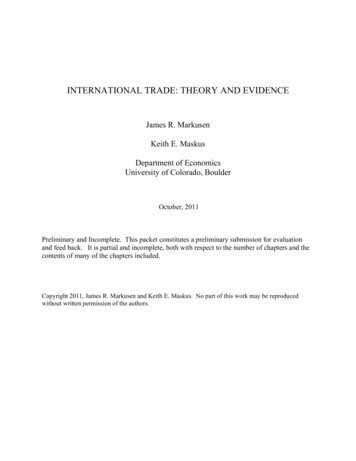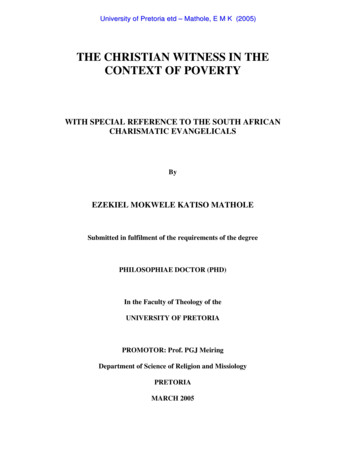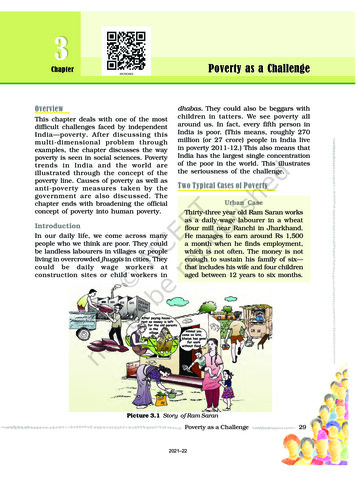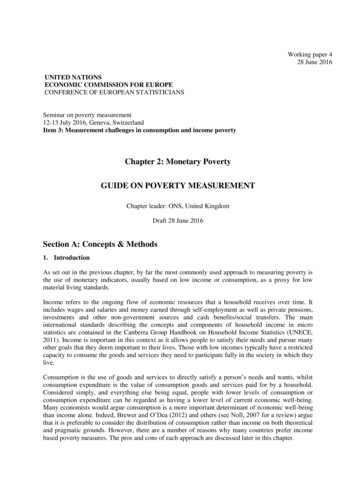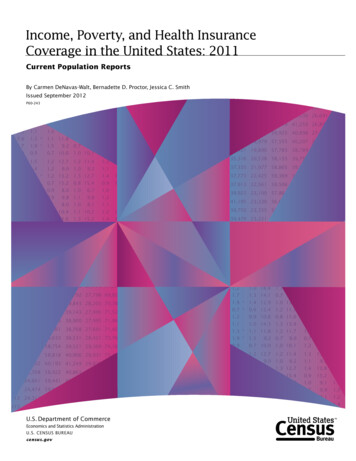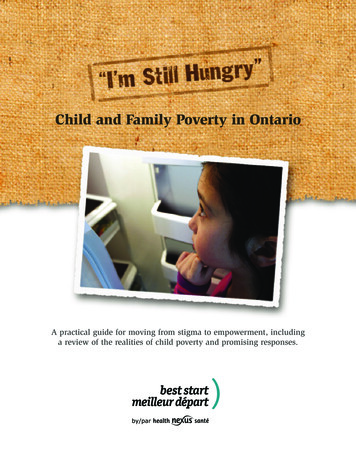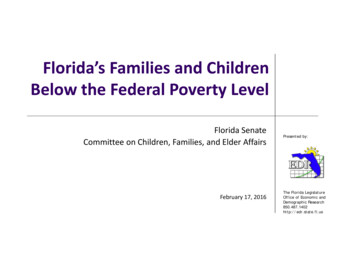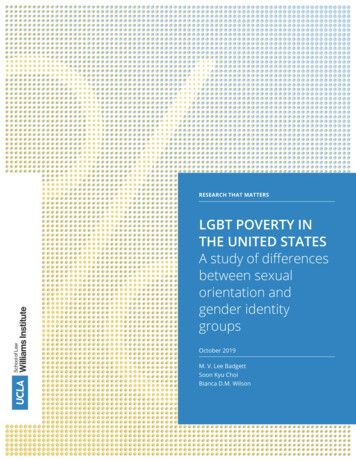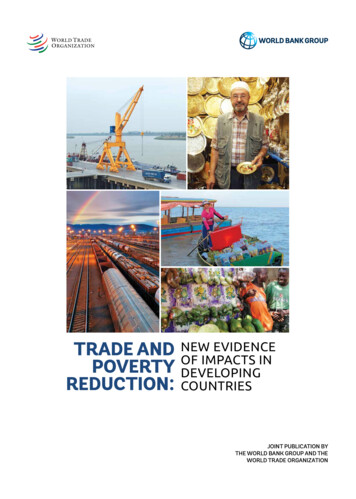
Transcription
EVIDENCETRADE AND NEWOF IMPACTS INPOVERTY DEVELOPINGREDUCTION: COUNTRIESJOINT PUBLICATION BYTHE WORLD BANK GROUP AND THEWORLD TRADE ORGANIZATION
DisclaimerThe designations employed in this publication and the presentation of material therein do not imply the expressionof any opinion whatsoever on the part of the World Bank, its Board of Executive Directors, or the governmentsthey represent, or the World Trade Organization concerning the legal status of any country, area or territory orof its authorities, or concerning the delimitation of its frontiers. The responsibility for opinions expressed in thispublication rests solely with their authors, and publication does not constitute an endorsement by the World Bankor the World Trade Organization of the opinions expressed. Reference to names of firms and commercial productsand processes does not imply their endorsement by the World Bank or the World Trade Organization, and anyfailure to mention a particular firm, commercial product or process is not a sign of disapproval.This volume is a co-publication of the World Bank and the World Trade Organization.Attribution—Please cite the work as follows: World Bank Group and World Trade Organization, 2018. Trade andPoverty Reduction: New Evidence of Impacts in Developing Countries. World Trade Organization: Geneva.Acknowledgements—This publication has been coordinated by Marcus Bartley Johns (WBG), Paul Brenton(WBG), Roberta Piermartini (WTO), Mustapha Sadni Jallab (WTO) and Robert Teh (WTO). The coordinatorswould like to thank Sandra Rossier for her assistance in the preparation of the publication. The production of thepublication was managed by Anthony Martin and Edmundo Murray. Design and layout of the publication wereundertaken by Corporate Visions, Inc.Copyright 2018 World Trade OrganizationISBN (paper): 978-92-870-4521-8ISBN (electronic): 978-92-870-4522-5Cover images: Bigstock and Flickr World Bankii
TRADE AND POVERTY REDUCTION: NEW EVIDENCE OF IMPACTS IN DEVELOPING COUNTRIESCONTENTS384ForewordThe Poverty Impact ofModernising Dar esSalaam Port498Trade and Poverty Reduction:New Evidence of Impacts inDeveloping Countries:Introduction and OverviewAgricultural Logistics inLagging Regions: Evidencefrom Uganda18120Is Tunisian Trade PolicyPro-poor?Trade Openness andVulnerability to Povertyin Viet Nam under Doi Moi36148Gender Welfare Effects ofRegional Trade Integration onHouseholds in GhanaGlass Barriers: Constraintsto Women’s Small-Scale,Cross-Border Trade inCambodia and Lao PDR58Exporting, Importing andWages in Africa: Evidencefrom Matched Employer-EmployeeData174Are the “Poor” GettingGlobalised?1
TRADE AND POVERTY REDUCTION: NEW EVIDENCE OF IMPACTS IN DEVELOPING COUNTRIES2
TRADE AND POVERTY REDUCTION: NEW EVIDENCE OF IMPACTS IN DEVELOPING COUNTRIESForewordIn 2015, the World Bank and the World Trade Organization published a flagship report on the role of trade in theeffort to end poverty by 2030. Over the past three years, the two organizations have collaborated in various ways toadvance that goal, from supporting implementation of the WTO Trade Facilitation Agreement; to assisting the poor,including women and small-scale traders, to take advantage of trade opportunities; to supporting trade reforms inthe world’s poorest countries.The latest report in this collaboration comes during an uncertain time for global trade. There is a trend away fromtrade openness, and the unstable trade policy environment has developed into one of the key risks facing the globaleconomy. It is essential that we do not lose sight of the significant implications for the poorest and most vulnerable.Trade is a key driver of global growth and poverty reduction. An open global economy has created opportunities forhundreds of millions of people to lift themselves out of extreme poverty.This new volume brings together contributions from researchers that detail the challenges and opportunities inmaximizing the impact of trade openness for the poor. It shows the need to continue to focus on reducing high tradetransaction costs faced by poor workers and consumers in developing countries, and it explains how the benefits oftrade can vary between rural and urban families, and between women and men. The papers in this collection alsodemonstrate the value of different research methods to understand links between trade and poverty, while alsohighlighting areas for further research and for testing new analytical methods.The collected analysis has important implications for policies and future research. It highlights how trade opennesshas clear, positive impacts on poverty reduction. For example, trade can benefit the poor by reducing the price ofwhat they consume and increasing the price of what they sell. As producers, the poor can gain by selling their outputin overseas markets where they can get a better return. Trade can also benefit the poor because it allows producersof domestic goods to respond to adverse shocks to domestic supply chains by shifting sourcing abroad. Trade canalso help particular groups. For example, one of the case studies in this book finds that exporting firms in Africa tendto pay women workers more than non-trading firms.For some sectors and groups, however, the research shows serious challenges. One example is lower incomes dueto import competition. Another is the risk that various “behind the border” barriers – like limited competition intransport and distribution, weak infrastructure, or a lack of information on new opportunities – will negate thebenefits of export opportunities or lower-cost imports.Understanding these issues is essential for designing complementary policy reforms to help maximize the overallpositive gains of trade openness for the poor. This requires more policy-relevant research, as well as an effort toaddress data constraints in areas such as services trade or the impact of non-tariff measures.With recent World Bank forecasts indicating that the pace of poverty reduction is slowing, there is an urgent need tointensify reforms and increase investments that help the extreme poor. Maximizing the benefits of trade opennessfor everyone, especially the poorest and most vulnerable, will be critical to driving inclusive, sustainable economicgrowth and finally ending extreme poverty on the face of the earth.Jim Yong KimRoberto AzevêdoPresidentDirector-GeneralWorld Bank GroupWorld Trade Organization3The Role of Trade in Ending Poverty
TRADE AND POVERTY REDUCTION: NEW EVIDENCE OF IMPACTS IN DEVELOPING COUNTRIESTrade and Poverty Reduction:New Evidence of Impacts inDeveloping Countries:Introduction and OverviewIn recent years there has been an intensification of thelong-running debate on the effects of trade integration.This debate has focused largely on the impact of tradein advanced economies, which has risked divertingattention away from the impact of trade on people’s livesin developing countries, and especially the extreme poor.This volume brings together new research, using a rangeof different analytical approaches, that examines how theextreme poor have fared following trade liberalizationin various developing countries and regions and thechallenges that poor people face in benefitting from trade.The 2015 joint report emphasized that the greatestimpact on poverty reduction will come from a coherentand multi-pronged approach that addresses these specificconstraints. To this end, the report discussed policy actionsthat governments can take individually and collectively toTrade has been recognized as an engine for inclusiveeconomic growth and poverty reduction in the 2030Agenda for Sustainable Development. The 2015 jointWTO-World Bank publication, The Role of Trade in EndingPoverty strengthened the evidence that trade has playeda critical role in poverty reduction and that the furtherintegration of developing countries into an open globaleconomy will be essential for achieving the goal of endingextreme poverty by 2030.(ii) Improving the enabling environment includingpolicies related to human and physical capital,access to finance, governance and institutions,and macroeconomic stability;maximize the gains from trade for the poor:(i)Lowering trade costs for deeper integration ofmarkets, tackling policy and infrastructure barriersto goods and services trade are critical to growthand poverty reduction;(iii) Intensifying the poverty impact of integrationpolicies by bringing a greater focus on tacklingremoteness from markets at the sub-nationallevel, and facilitating the activities of poor andsmall traders;That publication (hereafter referred to as the “2015joint report”) has contributed to focusing the debate onthe challenges that the extreme poor face given theirvulnerability, as well as the strategies that are mosteffective in maximizing the positive impact of trade. One ofthe main messages of the 2015 joint report was that tradeopenness or trade growth alone may not be sufficientto end extreme poverty. The extreme poor face specificconstraints—due to the fact that they tend to work in ruralareas, in the informal sector, live in fragile states and facegender inequality—that can limit their ability to benefitfrom wider trade-induced economic gains.(iv) Managing and mitigating risks faced by the poorthat limit them from benefiting from tradeopportunities when they arise and build poorpeople’s resilience to the effects of adverseevents; and(v) Improving data and analysis to inform policy tobetter understand the trade-related constraintsthat the poor in many countries continue to faceincluding through the use of new technologies fordata generation and analysis, including big data.4
TRADE AND POVERTY REDUCTION: NEW EVIDENCE OF IMPACTS IN DEVELOPING COUNTRIESThe present volume builds on this, surveying subsequentwomen within the household. Trade can further affectresearch and presenting a series of country-level studieslong-term development outcomes if it leads declinesto complement the global approach taken in thein child malnutrition rates, higher school attendance2015 joint report. It continues to focus on the linkagesand performance etc. The effect of trade on the poorbetween trade and extreme poverty rather than thedepends on the specific mechanism at play, the naturebroader distributional effects of trade and the agendaof trade policy change (whether it increases importof shared prosperity. It seeks to build understanding ofcompetition or market access), the specific industrythe challenges surrounding each of the four constraintsor firm where the poor work and household decision-that were the focus of the joint report, as well asmaking. In this book we focus on how the effects of tradeidentifying ways to overcome them, thereby maximizingdepend on informality, geographical location (rural orthe contribution of trade to poverty reduction. The caseurban area) and gender.studies included in this volume reinforce the need toTrade can benefit the poor by spurring economic growth.move forward with the above agenda to maximize theSustained economic growth is the most powerful toolgains from trade for the poor. One of the main objectivesfor poverty alleviation. A household’s income is derivedof the current volume is to bring a focus to the countryfrom sale or utilization of its resource endowmentsand regional level, providing insights and examples of(landholdings, capital, labour or human capital). Peopleanalytical methods that can be drawn upon for work inare poor because they have few endowments orother countries and regions.1because the rewards received from those endowmentsThe chapters contained in this volume highlight some neware low. Typically, the poor suffer from both afflictions.analytical approaches to understanding and addressingRapid and sustained economic growth allows the poorthe linkages between trade and poverty, while alsoopportunities to increase their initial endowments (saveshowing the ongoing challenges facing the research andto accumulate capital, get an education to increasepolicy community in this work. Before summarizing eachhuman capital) and to earn better rewards for supplyingchapter, this section reviews the recent literature ontheir resources to others, typically through the market.trade and poverty, noting where chapters in this volumeAnother avenue through which trade can spur economiccontribute to the literature. This overview chaptergrowth is by increasing the pace of innovation by firms.concludes by discussing the main policy implications ofFirst, trade liberalization increases the size of the marketthe chapters and priorities for future work.and the incentives to innovate. Second, to the extentthat technical knowhow is embodied in products, tradeOverview of the recent literature on trade and poverty,including links with the current volumeliberalization makes possible knowledge spill-oversthrough improved access to imports. Third, an increasein the degree of openness of an economy will typicallyThe economic literature suggests that trade opennessenhance product market competition. The increaseis key to poverty reduction, but must be part of a widerin productivity means more output or income can beeffort. Trade influences the income of the poor throughobtained by society, and therefore also by the poor, fromvarious channels: through its effects on economica given amount of resources.growth, relative prices, macroeconomic stability andon government revenues (Winters, 2002 and WintersTrade can benefit the poor by reducing the price ofet al., 2004). The impact of trade on poverty thenwhat the poor consume and increasing the price of whatdepends on decisions within the household on howthe poor sell. Trade opening changes relative prices inincome is allocated. Trade can itself influence howboth product and factor markets. These changes affectsuch decisions are made, for example by empoweringthe members of the household as both consumers and1The chapters for this report were selected following a call for papers by the WTO and World Bank that provided new empirical work on the trade and poverty nexus. There was an explicitrequest for papers that addressed issues relating to rural poverty, fragility and conflict, gender and informality. Perhaps reflecting the challenges of data, there were few submissions thataddressed trade, poverty and conflict or that had an explicit focus on informality. In selecting papers for inclusion, beyond quality the volume has sought to capture evidence from a range ofcountries in different regions.5
TRADE AND POVERTY REDUCTION: NEW EVIDENCE OF IMPACTS IN DEVELOPING COUNTRIESTrade reforms can create new opportunities,but also involve adjustment costs for thepoor. Access to international markets maydeliver higher average incomes to farmerswho specialize in producing export crops, butmay bring greater competition that reducesthe demand for poor workers in importcompeting sectors.sellers of goods and factors of production (e.g., labour).of trade reforms may not reach the poor, if they are notAs producers, the poor can gain by selling their outputconnected to markets. This can be the case for the ruralin overseas markets where they can get a better return.poor, who tend to be low skilled and less mobile thanAs producers, the poor are also consumers of inputs.those living in urban areas. A study of Indian liberalizationTrade can allow them to get better access to material andin the 1990s (Topalova, 2007 and 2010) showed thatservices inputs and technology that improve productivityalthough poverty in India declined, it declined less forin the production of the goods and services that thehouseholds living in rural districts more exposed topoor produce. As consumers, trade liberalization canimport competition.be beneficial to the extent that it reduces the price forThe country studies in this volume also highlight theimported goods. As income earners, prices can affectdifferentiated impact of trade reform in rural comparedwages and employment.to urban areas. For instance, in Ghana, households inAs an example of how poor producers can benefit fromrural areas that are net producers of agricultural productstrade, there is evidence that the US-Viet Nam FTA hasexperience greater losses in welfare than households inhelped poverty reduction in Viet Nam. Families living inurban areas. The study on India (Mendoza, Nayyar andprovinces that benefitted from the largest cuts in thePiermartini) shows that the products of rural householdscosts of exporting to the US also saw the largest declineface an average tariff in overseas markets that is 10.9in poverty (McCaig, 2011).Benefits have also beenpercentage points higher than that faced by the productsextended to people working in the informal sector, asof urban households. This underlines the need to do moreexport opportunities have promoted the reallocationto address the sources of agricultural trade costs, includingof workers from micro-enterprises to the formal sectorweak internal connectivity as well as market access(McCaig and Pavcnik, 2014).barriers, in order to maximize the positive impact of tradeopening for the rural poor. In their study on the potentialThe challenge for policy, however, is to implement tradepass-through of price changes due to reforms at Dar esreforms in a way that the increases the likelihood thatSalaam port in Tanzania, Depetris-Chauvin et al. highlightthe benefits will reach the extreme poor. The benefitsthe extent to which domestic transport costs and lack of6
TRADE AND POVERTY REDUCTION: NEW EVIDENCE OF IMPACTS IN DEVELOPING COUNTRIEScompetition among intermediaries limit the gains of tradeTrade benefits the poor, if it is associated with greaterfrom being passed on to the poor in rural areas. The studydiversification and greater macroeconomic stability.by Kunaka, drawing on research in Uganda, highlightsMacroeconomic volatility is usually bad for the poorthe importance of information barriers for agriculturalbecause it can reduce economic growth and adverselyproducers seeking to participate in trade.affect the distribution of income and generateinequalities. The poor have little access to finance to beTrade reforms can create new opportunities, butable to tackle a period of tightened liquidity, thereforealso involve adjustment costs for the poor. Access tothey are the most affected by macroeconomic volatility.international markets may deliver higher average incomesIf domestic shocks are the major source of volatility, tradeto farmers who specialize in producing export crops, butcan help reduce volatility through export diversificationmay bring greater competition that reduces the demand(Caselli et al., 2012). For example, when a country hasfor poor workers in import competing sectors. Adjustingmultiple trading partners, a domestic recession or ato these changes can be costly. Poor workers may requirerecession in any one of the trading partners translatessome retraining or may need to move to another locationinto a smaller demand shock for its producers than whento access newly generated jobs. Also specialization intotrade is more concentrated.the production of one or few crops, for example, whileTrade allows domesticgoods producers to respond to shocks to the domesticincreasing income of the poor when prices are high, itsupply chain by shifting sourcing abroad. Geographicalmay reduce their income when prices are low. These costsexport diversification may also help reduce the impactare particularly difficult for the poor to bear given theirof country-specific external shocks (Jansen, Lennonlack of resources and limited access to finance. This isand Piermartini, 2015). In fact, a recent study by thecompounded by the lack of effective social safety nets inIMF (2014) finds a robust negative correlation betweenmany poor countries that can support poor people duringexport diversification and output volatility in low-incomeperiods of transition. Therefore, what should be short-countries.term adjustment costs from trade can turn out to havelong-term negative outcomes for the poor. The currentHowever, greater trade openness also implies greatervolume contributes to understanding the potential forexposure to external shocks—especially in outward-increased vulnerability of households in trade-exposedoriented industries. Countries with closer trade linkssectors because of trade liberalization, even whentend to have more tightly correlated business cyclestrade contributes to an overall increase in incomes and(Frankel and Rosen, 2008) suggesting that trade acts as areduction in poverty (Magrini and Montalbano).transmission mechanism to propagate a country specificshock to others. By leading to greater specialization inExisting evidence points to the importance of puttingoutput, trade reduces diversification in production andin place appropriate policies to smooth the costs ofmay make a country more susceptible to idiosyncraticadjustments for the next generation, as well as in theshocks. Kose and Riezman (2001) find that because ashort-term. For example, by increasing the demand forsignificant fraction of African countries’ exports areskills and when adequate information on this is provided,concentrated in a narrow range of primary commodities,trade can contribute to improved educational outcomes.terms of trade shocks account for 45% of the volatilityJensen (2012) shows that recruitment campaigns inin aggregate output. Moreover, adverse trade shocks canrural villages in India that provided information aboutcause prolonged recessions since they induce a significantjob opportunities in information technology (IT) in urbandecrease in aggregate investment. Koren and Tenreyroareas were associated with increased schooling of young(2007) also suggest that greater volatility in developinggirls. However, primary school attendance, especiallycountries arises from their initial specialization in thefor girls, declined in Indian regions more exposedmost volatile production sectors. Economic developmentto international competition (Edmonds, Pavcnik andinvolves diversifying away from these volatile sectors.Topalova, 2009 and 2010).7
TRADE AND POVERTY REDUCTION: NEW EVIDENCE OF IMPACTS IN DEVELOPING COUNTRIESOpening up to trade may put the poor at risk, if it reducesThe current volume includes a number of studies thatgovernment revenue. The poor benefit from the provisiondeepen our understanding of how the impact of tradeof public goods and may be helped by governmentreform may not necessarily be the same for women as ittransfer programmes. What happens to customsis for men. This is important since in many poor countriesrevenues after trade reform can therefore matter greatlywomen and female-headed households typically have ato the poor since the share of trade taxes in governmenthigher propensity to be poor than men and male-headedrevenues is typically high in poor countries.households.However, connecting to global markets does notThe chapter on Ghana (Orkoh) finds female-headednecessarily lead to lower government revenues fromhouseholds are likely to benefit more from thetrade. At first glance, trade liberalization will reduce tariffimplementation of the ECOWAS Common External Tariff,revenues and this will certainly occur if all trade taxes areespecially in urban and coastal areas, as they are morereduced to zero. However, fostering trade may involvelikely to be net consumers of products where prices aremeasures that do not affect tariff revenues. This is theexpected to decline. The chapter on trading firms incase for reforms that reduce red tape at the border.Africa (Duda-Nyczak and Viegelahn) finds that exportingAlso, liberalization typically stops short of complete tarifffirms tend to pay more to women workers than non-elimination. The “Laffer curve” analysis suggests thattrading firms. Combining qualitative and quantitativethere is a tariff rate that maximizes customs revenues; ifdata on small-scale, cross-border traders in Lao PDRthe initial tariff rate is above this rate, tariff liberalizationand Cambodia, Seror, Clarke and Record document thatcan actually increase customs collection. Furthermore, towomen face both visible and invisible constraints tothe extent that quantitative restrictions are replaced byparticipating in cross-border trade, although they mighttariffs, new sources of tariff revenues will be generatednot be as great as those faced by women traders in Africa.by trade reform. In many countries non-discriminatoryTheir study underlines the importance of adequate borderconsumption taxes, such as a value-added tax, are alsoinfrastructure, streamlined border procedures, andlevied at the border. Hence, while tariff revenues will fall,access to finance. The chapter on India (Mendoza, Nayyarrevenues from consumption taxes applied to importedand Piermartini) calculates that women consistently facegoods will rise and mitigate the overall revenue loss.higher tariffs in overseas markets than men. On average,Finally, lower customs revenues will be partially or whollywomen’s tariffs are 6 percentage points higher thanmade up for by greater collection of domestic taxesthose that men face, based on the type of work in which(holding tax rates constant), as economic activity andthey are employed. These studies reinforce the need togrowth is stimulated by trade opening.assess the gender implications of trade reforms and toidentify and address if there are particular challengesFinally, trade opening can affect the way decisions arethat women face to benefit from the opportunities ormade within the household, which can have an importantdeal with the risks that trade brings.impact on poverty. This is particularly the case if tradeempowers women within the household by creating jobsIn sum, the discussion above has stressed that there arefor women that would not otherwise be available. Forseveral channels through which international trade affectsexample, cross-border trade in Africa provides income forpoverty. Evidence shows that not all the poor are affectedhundreds of thousands of poor women. The emergence ofequally. The effects will depend on where they live (ruralthe apparel sector in Bangladesh has created substantialversus urban areas), their individual characteristics (skill,jobs for women and has contributed to changing socialgender), the type of trade policy change (increasedattitudes towards women and girls. The empowermentimport competition or export opportunities) and whereof women within the household is typically associatedthey work (industry, firm, formal/informal sector). Sincewith better nutritional and educational outcomes forthe effects are context specific, case study analysis of thechildren, which in turn leads to higher productivity in thetype we present in this book is very important to betterlong-term. Hence, the nexus between trade and gender isunderstand the variety of channels through which tradea critical area for attention.can affect poverty.8
TRADE AND POVERTY REDUCTION: NEW EVIDENCE OF IMPACTS IN DEVELOPING COUNTRIESEvidence showsthat not all the poorare affected byinternational tradeequally. The effects willdepend on where theylive (rural versus urbanareas), their individualcharacteristics (skill,gender), the type oftrade policy change(increased importcompetition or exportopportunities) andwhere they work(industry, firm, formal/informal sector).Description of the chapters in the current volumeIn one of a number of papers on African countries,Martínez, Baghdadi and Kruse examine the relationshipbetween the reduction of most-favored nation (MFN)tariffs, the conclusion of several free trade agreements,and implementation of streamlined trade proceduresfrom the 1990s to 2005 in Tunisia and the decline inpoverty. The authors estimate that the fall in the pricesof consumer goods from further tariff reduction wouldimprove the welfare of low-income households by about1% of expenditure, but would not improve welfare forricher households (with similar distributional resultsacross regions). This limited gain reflects a conservativecalculation of the likely pass through of changes intariffs to domestic prices; the higher pass through rateused in similar studies would result in significantly largerwelfare improvements. Lower consumer goods pricesare estimated to benefit rural households more thanurban households, improve average welfare in femaleheaded and male-headed households by about the sameamount, and improve welfare for self-employed, poorworkers only slightly more than for more formal workers.Household welfare also improves because lower tariffstend to increase wages. However, wage data are availableonly at the industry rather than individual level, and thisestimation is not reliable.Orkoh assesses the welfare effects of changes in thedomestic prices of commodities as a result of Ghana’sadoption of the common external tariff of the EconomicCommunity of West African States (ECOWAS), with specialattention to gender differences. These price changeswould improve the welfare of poor and female-headedhouseholds as consumers, but reduce the welfare ofboth poor and rich households as producers, with maleheaded households being the most affected. The neteffect is around zero for poor male-headed householdsand negative for the rich, but positive for female-headedhouseholds in the low- and middle-income categories.While the results also depend on the geographic locationof the household, among other factors, the reform isthus expected to have pro-poor and pro-female effects.The study recommends that the government introducescompensatory policies, such as income transfers thatwould target male-headed households that are producers9
TRADE AND POVERTY REDUCTION: NEW EVIDENCE OF IMPACTS IN DEVELOPING COUNTRIESand streamline the ongoing Livelihood EmpowermentDepetris-Chauvin et al. assess the likely welfare andAgainst Poverty Programme to help poor, male-headedpoverty impact of a project t
trade openness, and the unstable trade policy environment has developed into one of the key risks facing the global economy. It is essential that we do not lose sight of the significant implications for the poorest and most vulnerable. Trade is a key driver of global growth and poverty reduction. An open global economy has created opportunities for

